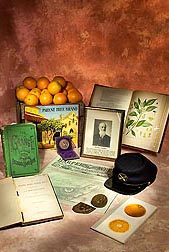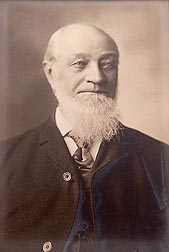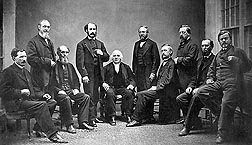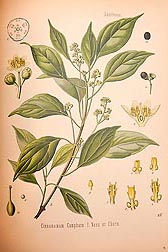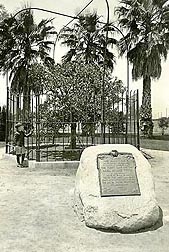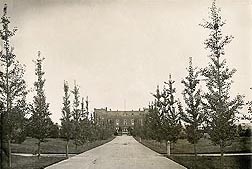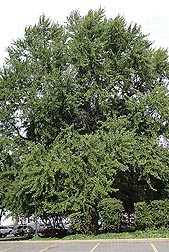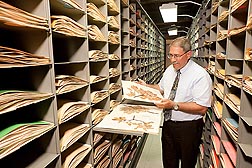William Saunders: A Monumental Figure in USDA
One hundred and fifty years ago, on November 19, 1863, President Abraham Lincoln delivered what would come to be known simply as the “Gettysburg Address” at the dedication of the Gettysburg battlefield cemetery.
Doesn’t sound like an agricultural story, does it?
But it was William Saunders, the first horticulturist and superintendent of experimental gardens with the newly created U.S. Department of Agriculture, whom President Lincoln called on to fashion a national cemetery at Gettysburg, one to be unlike any preceding monument for the fallen.
What Saunders created was a revolution in battlefield cemeteries. He used a simple radial configuration grouping Union dead by state (Confederate bodies were returned to their home states), with each grave marked by a flat, gray, granite rectangle. Surrounding the graves, Saunders created an extensive planting plan to frame the site’s vistas, specifying uncommon choices of trees and shrubs. Many of the trees and shrubs were those recently introduced to this country by Saunders himself.
This combination—no grand headstones or sculptures and extensive green landscaping—was unique, never previously seen in either Europe or the United States.
At President Lincoln’s request, Saunders spent an evening at the White House presenting his proposed design. The President heartily approved.
“He [Lincoln] was much pleased with the method of the graves, saying it differed from the ordinary cemetery, and after I had explained the reasons, said it was an admirable and befitting arrangement,” Saunders recounted in a historical journal that is part of the National Agricultural Library (NAL) Special Collections. The library is part of USDA’s Agricultural Research Service.
In addition to what was to become the Soldiers’ National Cemetery at Gettysburg, Saunders went on to design the landscaping for Lincoln’s tomb, the west façade of the Capitol, and many other important locations. While still the USDA superintendent of experimental gardens, Saunders became president of the Washington, D.C., Parking Commission, where he developed a system of parks and street tree plantings that became an enduring foundation for the city’s reputation as the “City of Trees.” He oversaw the planting of 80,000 trees in Washington, D.C.
Introducing New Plants
But Saunders did far more for the country than design landscaping.He also introduced hundreds of economically important plants, including Japanese persimmon; Eucalyptus globulus tree; Japanese cedar (Cryptomeria japonica); 300 varieties of winter-hardy apples from Russia that had a profound effect on the Northeast’s apple growing; camphor tree; one of the first magnolia trees in Washington D.C.; and many more.
If you had to pick out a single plant introduction as Saunders’s legacy, it would be the Washington navel orange. According to the 1937 “USDA Yearbook of Agriculture,” introduction of the Washington navel orange was considered “one of the outstanding events in the economic and social development of California.”
In “A History of the Parent Washington Navel Orange Tree,”Chester N. Roistacher wrote: “This new, large, sweet and seedless fruit was a marvel to see and taste in contrast to the small and seedy fruit on the existing seedling trees then present in California. The arrival of this new variety, so excellently adapted to the climate of California, was largely responsible for the development of many new cities, fruit packing houses, inventions in boxing machines, fruit wraps, and the iced railroad car.”
In his journal, Saunders described how he brought about the introduction: “Sometime in 1869, the then Commissioner of Agriculture, Horace Capron, brought to my attention a letter which he had just received from a correspondent in Bahia, Brazil. Among other matters, special mention was made of a fine seedless orange of large size and fine flavor. Thinking that it might be of value in this country, I noted the address of the writer and sent a letter asking to be the recipient of a few plants of this orange. This request brought, in course of time, a small box of orange twigs, utterly dry and useless. I immediately sent a letter requesting that someone be employed to graft a few trees on young stocks and that all expenses would be paid by the Department. Ultimately a box arrived containing 12 newly budded trees and, being packed as I had suggested, were in fairly good condition.”
Eventually, in 1873, Saunders presented two of the navel orange trees, which he was calling the “Bahia navel,” to an old friend, Eliza Tibbets, who was moving from Washington, D.C., to join her husband in the new community of Riverside, California.
|
|
Tibbets had contacted Saunders for suggestions of a crop that would prosper in Riverside’s arid, Mediterranean climate. Riverside’s early settlers needed to find a crop that would do well in their dry and dusty environment to ensure the town’s survival. Various other crops had had only moderate success.
The navel orange was an immediate success and quickly spread to other parts of California. Luther Holt, publisher of the Riverside Press and Horticulturist, called it the “Riverside navel.” But cities around Riverside objected to that name, and eventually it was changed to the “Washington navel,” in honor of the source city—or perhaps our first president.
Because the Washington navel orange is seedless, all of its many, many descendants are grafts from those original two trees. One of those trees, planted in downtown Riverside and now more than 140 years old, is alive and healthy.
But far broader in impact than Saunders’s individual introductions, even as important as many of them have been, was his codifying of the mission of the USDA Experimental Gardens, which he headed from his initial appointment in 1862 until his death in 1900. These guidelines were presented in his “Catalogue of the Plants, Bulbs, Tubers, Etc., for Distribution from the U.S. Propagating Garden with a Report on the Objectives and Aims of the Garden.”Dated 1862, this catalog, with the guidelines, was USDA’s very first publication. It is available in NAL’s Special Collections.
|
|
The guidelines called for USDA to not only procure new and better plants for the country, but also to “ascertain, by experiment, the influences of varied culture” and “to investigate more thoroughly the various maladies and diseases of plants and the insects that destroy them.”
That “by experiment” was Saunders’s most significant contribution. He originated the standard for systematic evaluation and reporting about the characteristics of the thousands of new plants being introduced into the United States, explains ARS Deputy Assistant Administrator Robert Griesbach. ARS is the USDA agency that has inherited the Department’s germplasm collecting-and-preservation mission.
“What William Saunders did was set out that all of the important traits of a variety should be evaluated at the same time and under several sets of growing conditions,” Griesbach says. “That sounds so obvious now, but before Saunders, evaluations were really just hit or miss. Rarely was an effort made to gather all the information and publish in one place. Most of the work was published by gentleman farmers and amateur plant breeders, who were often only interested in a single trait.”
|
|
For instance, in just 2 years, from 1865 to 1867, the USDA Experimental Farm was used to evaluate and propagate more than 120 wheats, 167 ryes, 230 melon varieties, 70 peas, 50 grass species for hay production, and more than 500 strawberries, grapes, apples, and pears. That information was published and made available to farmers.
“The precedent that Saunders set has had a profound effect, right down to the way we work today,” Griesbach adds.
Tappahannock wheat is a typical example. Beginning in 1866, it was identified in the evaluation program as a superior wheat cultivar, noted for its high yields, early maturity, disease resistance, and flour quality. Saunders distributed the wheat to farmers in many locations and requested that each report back on the traits and success of Tappahannock. His correspondence demonstrated that the cultivar was widely adapted to many regions of the country, from New England to the lower South and through the Midwest.
|
|
A report from Giles County, Tennessee, to USDA stated that Tappahannock wheat “sown the 10th of October, ripened two weeks earlier than other varieties and yielded one-fourth more of excellent wheat.” Braxum County, West Virginia, reported similarly, adding that “it was free from rust and the weevil.” These are just two of the extensive reportings Saunders collected and made available in the “Report of the Commissioner of Agriculture for the Year 1868.”
Even the New York Times recognized the importance of collecting, evaluating, and distributing information about new varieties. In an article published April 26, 1873, it cited the “wheat crop in 1862. . . average yield per acre was 12.1 bushels. With Tappahannock, wheat distributed by the department showed an average yield per acre of twenty-five bushels.”
The article went on to conclude that “such are some of the objects and achievements of the Farmers’ Department of the Government. It has only now [1873] entered fairly upon its work of advancing agricultural science and elevating agricultural industry. But it promises glorious results in the near future, from which the ‘lords of the soil’ will be directly and largely benefited and the national wealth increased.”
There is no question this prediction has come true. Today, U.S. agriculture provides the people of this country with a bountiful low-cost diet, and in 2012, U.S. agricultural exports totaled more than $141 billion.
When Saunders died in 1900, USDA statistician John Hyde was quoted in the New York Times obituary as saying that “the department has not begun to exhaust the suggestions of value made by Mr. Saunders.”—By J. Kim Kaplan, Agricultural Research Service Information Staff.
For information about the materials or people mentioned in this article, contact Kim Kaplan, USDA-ARS Information Staff, 5601 Sunnyside Ave., Beltsville, MD 20705-5128; (301) 504-1637.
"William Saunders: A Monumental Figure in USDA" was published in the September 2013 issue of Agricultural Research magazine.







